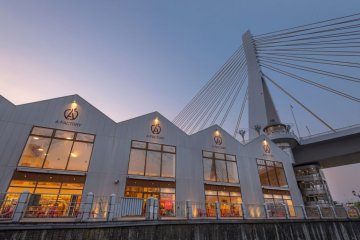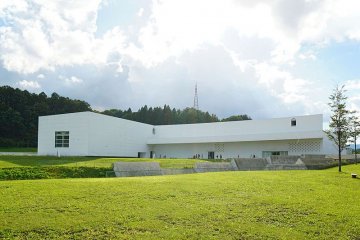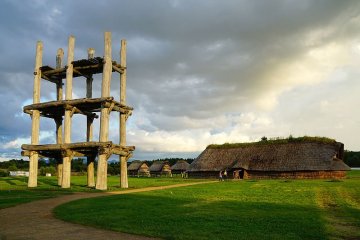

睡魔之家WA・RASSE於2011開幕,是青森車站周邊復興計劃之一。在這裡有深入的睡魔祭歷史、介紹、以及花車——每年均有四台新的花車輪流展示。
以青森地區的祭典愛好者為對象,WA.RASSW以每年在青森灣埠頭舉辦的睡魔祭為主。博物館的外觀設計也是源自於青森的根本,對許多遊客來說看起來像是紅色蝴蝶結,其實是重現透過青森古老森林的光線。這個有趣的外觀設計,也幫助博物館減少外來的自然光。
遊客從睡魔之家WA・RASSE的2樓開始導覽。在學習祭典的相關知識,並閱覽過歷史照片後,遊客們會被帶到一個陽台,俯瞰整個主要展示區域。暗沉燈光的那裡,便是真的睡魔花車展示的地方。由於房間偏暗,能看到花車以如同夜間祭典般的鮮艷色彩展示。
這裡也有其他互動活動,以及一個30分鐘長的體驗,一天有三次。看著這些展示,遊客們可以體會青森睡魔祭的實際參加感受。
距離JR青森站步行僅數分鐘。

A-Factory in Aomori Prefecture is a premier duty-free marketplace that houses and sells various products, such as sweets, processed goods, fresh vegetables and fruits, and more wonders from all over Aomori, most notable are, of course, Aomori apples. Aomori remains the largest and most popular producer of apples in Japan. Opened in late 2010, in conjunction with the extension of the Tohoku Shinkansen line to Aomori, the market is located on the Aomori Bay and makes for a striking outline against the Aomori bay Bridge. For tourists visiting the capital of the prefecture, A-Factory is an easy and convenient stop for specialty products. As well as being a market for prefectural goods, the factory also serves as the brewery for an in-house apple cider that visitors can see being produced. By purchasing a tasting card, guests can even sample the freshly produced cider of A-Factory. In addition, there are several eateries and restaurants inside, ranging from burgers to apple fries. All of the shopping and sampling and eating that awaits inside of A-Factory can also be enjoyed on the terrace or with a bay view from the large windows.

Since opening in July 2006, the Aomori Museum of Art has been active in having exhibitions, concerts, plays, and workshops by Aomori-native artists and performers. Most notably, Yoshitomo Nara, Shiko Munakata, Shuji Terayama, and Toru Narita are forerunners of the museum’s exhibits; with The Aomori Dog by Yoshitomo Nara being the museum’s symbol. The museum architecture itself is also an important part of the surrounding landscape and features as an exhibit itself. Designed by Jun Aoki to resembled the nearby Sannai Maruyama Historical Site excavation area, the simple walls and shape lend itself well to the beauty of the land. Atsuki Kikuchi, responsible for the visual identity of the building, decorated the exterior with stylized trees that represent the Aomori landscape and its connection to nature. With four floors of art to explore, the Aomori Museum of Art contains a theater, community gallery, restaurant, shop, and more in addition to its galleries. The galleries also contain artwork from international artists, such as Kandinsky, Klee, Matisse, Rembrandt, and Picasso. Visit this museum that brings nature and art together in a harmonious union.

The Sannai-Maruyama Site is a historically important archeological site and museum located in Aomori Prefecture. The ruins belonged to a large Jomon-period settlement and were originally rediscovered in 1992. The people of the Jomon age were known for their sedentary lifestyles and this settlement has provided artifacts as well as a look into the lives of the people of the past. Excavation of the site unearthed storage pits and above-ground storage further cementing the people as belonging to the region. The site has been designated a Special National Historical Site of Japan. Visitors may make their way to the site and see the reconstructions of Jomon-style architecture and artifacts native to the site. The Sanmaru Museum exhibits over 1700 artifacts and about 500 Important Cultural Properties that were all excavated from the Sannai-Maruyama site. Inside the museum, guests will be able to watch a video on the lifestyle of the Jomon people (with English audio devices available upon request). Alongside the artifacts from the Sannai-Maruyama site are figures that best represent how scientists believe the tools were used.